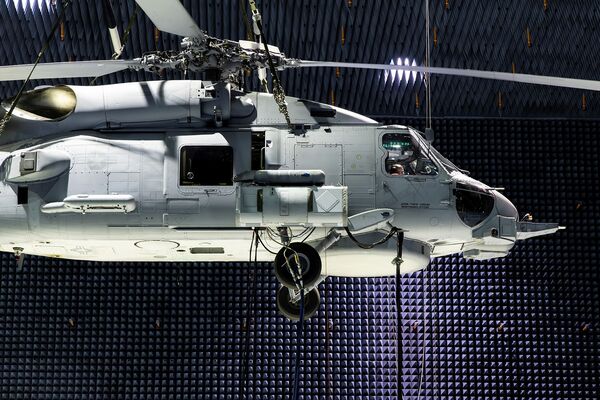
AOEW (the pod forward of the door) under test at the NAS Patuxent River anechoic facility. (Terri Thomas)
The US Navy (USN), supported by Lockheed Martin, has completed initial government testing of a new helicopter-borne electronic attack (EA) capability developed under the Advanced Off-board Electronic Warfare (AOEW) programme.
The final integration event, performed at an anechoic chamber facility at Naval Air Station (NAS) Patuxent River, Maryland, “tested the capabilities of the system and operability on the MH-60R helicopter platform”, said Lockheed Martin in a 12 December release.
Developed by Lockheed Martin Rotary and Mission Systems, the AOEW Active Mission Payload (AMP) – designated AN/ALQ-248 – is a podded capability designed to provide USN battlegroups with persistent electronic surveillance/countermeasure capabilities against anti-ship missile threats. Planned for integration on MH-60R and MH-60S helicopters, the AN/ALQ-248 AMP hosts both high-sensitivity receiver and high-power EA subsystems.
AN/ALQ-248 engineering development models previously underwent developmental and operational testing at Lockheed Martin's facility in Syracuse, New York. The tests at NAS Patuxent River saw Naval Air Warfare Center Aircraft Division engineers collect radio frequency performance data to measure pod performance and engagement capabilities in simulated tactical scenarios. Testing was performed in partnership with Naval Sea Systems Command (NAVSEA), the Naval Research Laboratory, the Johns Hopkins Applied Physics Laboratory, and Lockheed Martin.
According to Lockheed Martin, the event “marked the first time in the programme's development the system was able to perform engagement testing, demonstrate the ability to deter threats, and quantify system performance, while integrated and controlled by the target platform”.
Looking to read the full article?
Gain unlimited access to Janes news and more...







